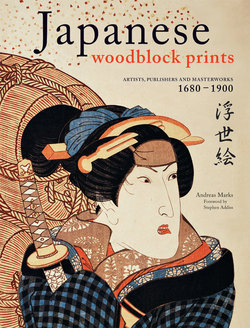Читать книгу Japanese Woodblock Prints - Andreas Marks - Страница 22
На сайте Литреса книга снята с продажи.
ОглавлениеBunchō
Act. c. 1755–90
Family name: Mori. Art name: Ippitsusai.
Not many details are known about Bunchō’s life. He was a book illustrator, painter, and print designer and is believed to have studied painting under the minor Kanō school painter Ishikawa Yukimoto (mid-eighteenth century). His earliest known works are the illustrations to the book Eiga asobi nidai otoko from 1755, written by Hachimonji Jishō II (1738–1815).
Bunchō predominantely designed actor prints in the narrow hosoban format of which the vast majority were produced between 1766 and 1774. These actor portraits are less aggressive and vigorous than portraits by his contemporary Katsukawa Shunshō, who was the foremost designer of actor prints in that time period. Bunchō’s beautiful women like in the two half-length series “Eight Views of the East” (Azuma hakkei) and “Appearance of the Eight Views” (Sugata hakkei), on the other hand, show the influence of Suzuki Harunobu but do not appear as romantic and fragile as Harunobu’s.
Nishimuraya Yohachi was the leading publisher of Bunchō’s prints. His most important work, however, was published by Kariganeya Ihei in 1770. The three-volume “Picture-book of Stage Fans” (Ehon butai ōgi) was produced with Katsukawa Shunshō. In an—until that time—unique compositional format, it shows the leading actors of the day on fans and is therefore considered one of the most important books in Japanese woodblock printing. These yakusha nigao-e (“pictures of likenesses of actors”) challenged the dominance of the Torii School in theatre illustrations. Bunchō captured actors in female roles (onnagata) whereas Shunshō drew the villains.
By 1772, Bunchō stopped designing actor prints and concentrated on pictures of beautiful women, a genre that he had already pursued in 1769. Bunchō’s last known work is a “pictorial calendar” (egoyomi) from 1790. Amongst his few students was Kishi Bunshō (1754–96).
1768 The actor ōtani Hiroji III in an unidentified role in the play Shuen Soga ōmugaeshi, Ichimura Theater, II/1768. Hosoban nishiki-e. Collection Peter Rieder. Hayashi 1981, no. 120.
Bunchō and Harunobu. c.1769-70 Imaginary armor pulling incident. Chūban. Library of Congress. Suzuki 1979, no. 368, and Hayashi 1981, no. 340.
1770 The actors Ichikawa Komazō II as Hanamori Kisaku and Yamashita Kinsaku II as Oume in the play Nue no mori ichiyō no mato, Nakamura Theater, XI/1770. Chūban. National Museum of Ethnology, Leiden, The Netherlands. Hayashi 1981, no. 252.
1770 The actor Sanogawa Ichimatsu II, from the “Picture-book of Stage Fans” (Ehon butai ōgi), vol. 1, p. 26. 16.7 x 25.9 cm (6.6 x 10.2 in.). Publisher: Kariganeya Ihei. Library of Congress.
late 1760s The actor ōtani Hiroji III in an unidentified role. Hosoban nishiki-e. National Museum of Ethnology, Leiden, The Netherlands. Unlisted in Hayashi 1981.
